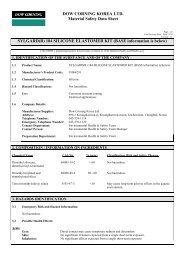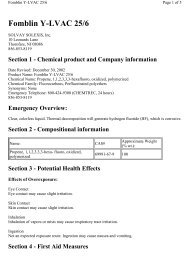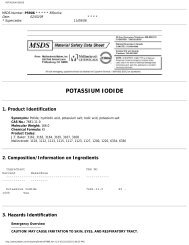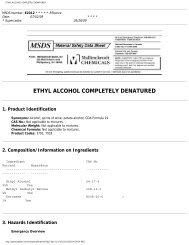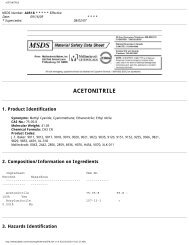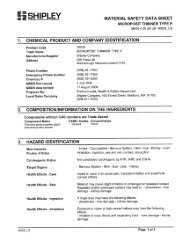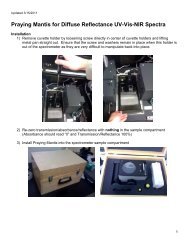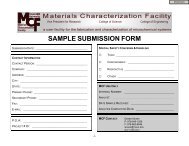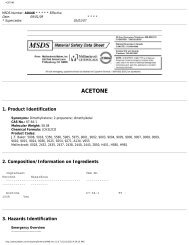ISOPROPYL ALCOHOL (90 - 100%)
isopropyl alcohol (90 - 100%) - Materials Characterization Facility
isopropyl alcohol (90 - 100%) - Materials Characterization Facility
- No tags were found...
Create successful ePaper yourself
Turn your PDF publications into a flip-book with our unique Google optimized e-Paper software.
<strong>ISOPROPYL</strong> <strong>ALCOHOL</strong> (<strong>90</strong> - <strong>100%</strong>)<br />
11. Toxicological Information<br />
Oral rat LD50: 5045 mg/kg; skin rabbit LD50: 12.8 gm/kg; inhalation rat LC50: 16,000 ppm/8-hour; investigated<br />
as a tumorigen, mutagen, reproductive effector.<br />
--------\Cancer Lists\------------------------------------------------------<br />
---NTP Carcinogen---<br />
Ingredient Known Anticipated IARC Category<br />
------------------------------------ ----- ----------- -------------<br />
Isopropyl Alcohol (67-63-0) No No 3<br />
Water (7732-18-5) No No None<br />
12. Ecological Information<br />
Environmental Fate:<br />
When released into the soil, this material is expected to quickly evaporate. When released into the soil,<br />
this material may leach into groundwater. When released into the soil, this material may biodegrade to a<br />
moderate extent. When released to water, this material is expected to quickly evaporate. When released into<br />
the water, this material is expected to have a half-life between 1 and 10 days. When released into water,<br />
this material may biodegrade to a moderate extent. This material is not expected to significantly<br />
bioaccumulate. When released into the air, this material is expected to be readily degraded by reaction<br />
with photochemically produced hydroxyl radicals. When released into the air, this material is expected to have<br />
a half-life between 1 and 10 days. When released into the air, this material may be removed from the<br />
atmosphere to a moderate extent by wet deposition.<br />
Environmental Toxicity:<br />
The LC50/96-hour values for fish are over 100 mg/l. This material is not expected to be toxic to aquatic life.<br />
13. Disposal Considerations<br />
Whatever cannot be saved for recovery or recycling should be handled as hazardous waste and sent to a<br />
RCRA approved incinerator or disposed in a RCRA approved waste facility. Processing, use or contamination of<br />
this product may change the waste management options. State and local disposal regulations may differ<br />
from federal disposal regulations. Dispose of container and unused contents in accordance with federal, state<br />
and local requirements.<br />
14. Transport Information<br />
Domestic (Land, D.O.T.)<br />
-----------------------<br />
Proper Shipping Name: ISOPROPANOL<br />
Hazard Class: 3<br />
UN/NA: UN1219<br />
Packing Group: II<br />
Information reported for product/size: 200L<br />
International (Water, I.M.O.)<br />
-----------------------------<br />
Proper Shipping Name: ISOPROPANOL<br />
http://www.jtbaker.com/msds/englishhtml/I8840.htm (5 of 7) [2/12/2010 4:57:41 PM]



